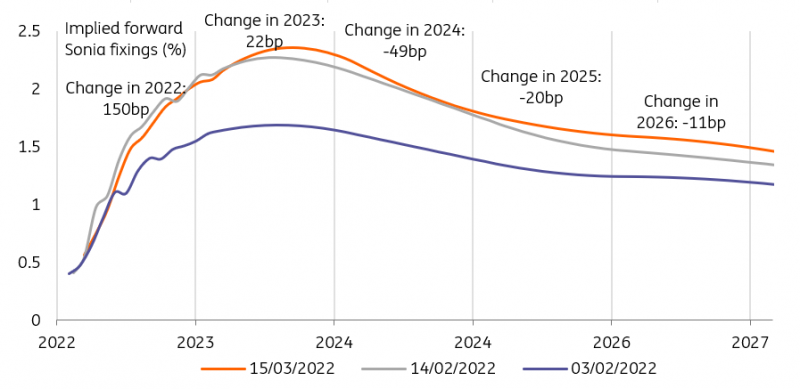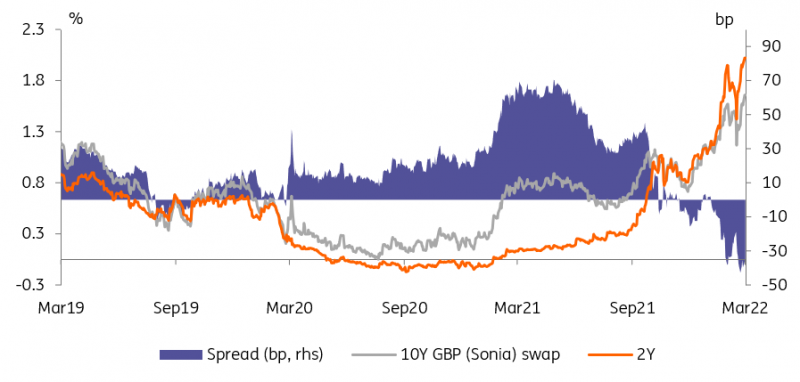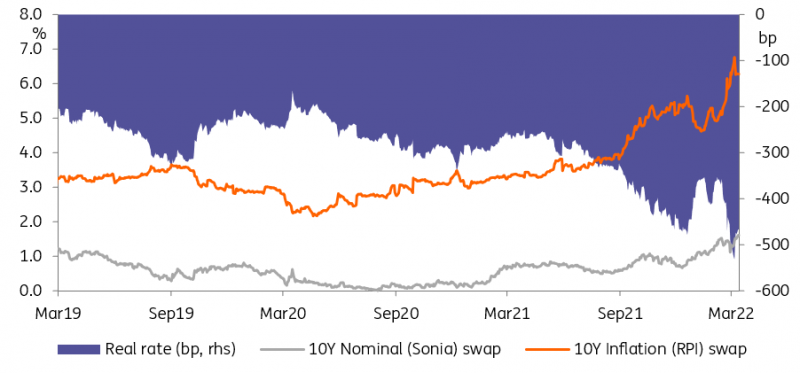The war in Ukraine means that UK inflation is going to stay higher for longer. It’s likely to peak at 8% in April but could peak even higher later in year should energy prices surge higher once more. Markets have concluded that this means the Bank of England will double-down on its tightening plans. And in the short-term investors are probably correct, in that we’d expect the Bank of England to hike rates for the third time this week, and probably again in May.
Policymakers have made it abundantly clear that they want to get some pre-emptive tightening done to mitigate against their concerns about higher inflation rates becoming more sustained.
However, we suspect the Bank will opt for another 25bp rate rise this week, rather than a larger 50bp move. While four out of nine policymakers voted for such a move back in February, the remainder of the committee indicated that they worried such a move would simply add further fuel to market interest rate expectations. Markets are pricing even more tightening than they were back then—six rate hikes in total this year. Comments from officials have offered some modest pushback against these expectations, and we may well see more of this on Thursday.

Our own view is that after a couple more rate hikes, the committee is likely to pause and put greater emphasis on the deteriorating growth backdrop. After all, such a sharp rise in oil and gas prices is more likely to be medium-term disinflationary, even if it keeps headline inflation rates higher this year.
Remember too that as of May, assuming Bank rate hits 1% as we expect, policymakers have signaled they may start actively selling assets to accelerate the Quantitative Tightening process. While the committee would probably like to separate this process as much as possible from rate hikes, it is a policy potentially fraught with risks – not least how the Bank would avoid selling assets into a sharp risk-off period. As such, we think the start of this process would be another argument in favor of pausing hikes from the spring.
Rates markets: too much tightening priced in but some upside to long end rates
Rates markets go into the March BoE meeting rightly expecting the BoE to add a third hike in this cycle. As things stands, the Sonia curve implies a small chance of a 50bp hike, but we think this is a marginal view among market participants. By any account, the amount of tightening the BoE would have to deliver to prove current valuations right is ambitious. Despite repeated hints from MPC members, this discount hasn’t shrunk. The question is, what would it take for it to reverse?

One problem is that BoE hike expectations aren’t happening in a vacuum. Other DM central banks edging closer to their own hiking cycle (with the Fed also likely hiking this month) means hawkish pricing remains the path of least resistance. Sterling rate markets are in a different position than their dollar peers, however. The BoE has already hiked twice, so the ‘pre-emptive’ part of its tightening is already well underway, and markets are thus more likely to pay attention to the growth risk of higher energy prices.
In this context, an inverted yield curve (in the forwards but also in some spot tenors) makes sense. It is either consistent with the BoE being forced into tightening more than the economy can stomach, and thus causing a recession, or with the view that the BoE will be closer to the end of its tightening cycle than to the beginning after this week’s hike. Whichever is true (we think the latter), this state of play could be reversed by a more cautious tone at this meeting, for instance if the camp in favor of 50bp hikes shrinks compared to February, or if the BoE signals more strongly that inflation should drop below 2% within its forecast horizon.

Even so, long end nominal rates still have room to rise in the near-term, led by real rates. The difference between nominal and inflation swap rates is still well below its February peak, by 27bp, and below what one would expect well into a central bank tightening cycle, by over 100bp compared to the previous cycle. In practice this is likely to be reversed by a convergence of inflation and nominal swaps but this signals that swaps have not yet seen the peak in this cycle.
FX: EUR/GBP should be making a low this year
Like many currencies, Sterling has witnessed a wild ride over recent weeks and realized volatility is back to levels last seen in early 2021. EUR/GBP made it very close to 0.8200 in early March but has since recovered quite strongly.
For the last six months or so we have taken the view that the BoE would welcome Sterling strength as a means to insulate against higher imported energy prices. We suspect that this is still the case, but for Sterling to stay strong the BoE will have to keep aggressive tightening expectations alive. As discussed above, the key question for financial markets this Thursday is how aggressively the BoE wants BoE tightening expectations re-priced?
Unless the BoE issues a strong rates protest on Thursday, we suspect EUR/GBP can continue trading in the 0.8300-0.8400 range. But a return to 0.8200 looks like something of a stretch now. And as we move into the second half – and assuming the ECB is ready to start tightening in 4Q22 – EUR/GBP should be starting to turn higher. As we outline on our FX forecasts page, EUR/GBP may be putting in a significant low near 0.82 this year and could be trading nearer 0.88/90 into 2024.
